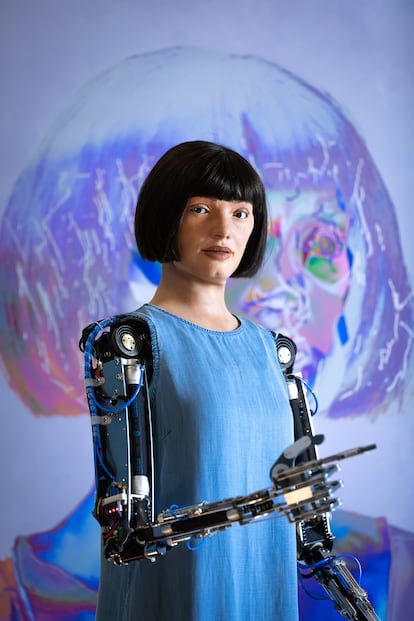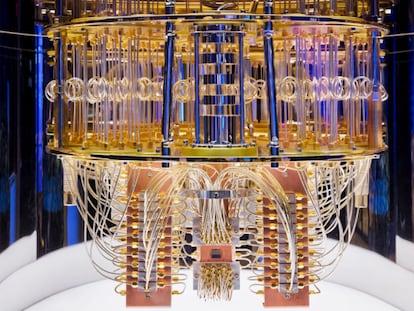Meet Ai-Da, the world’s first robot artist
This creative humanoid has authored poems, paintings and sculptures, and will showcase her skills at the upcoming Venice Biennale

“The biggest change in human history will take place in the next decade,” warns Aidan Meller, a Briton who ran an art gallery for 20 years until he became a pioneer by launching the world’s first creative robot, Ai-Da. Introduced in 2019 as “the first humanoid artist,” Ai-Da not only creates poems, paintings and sculptures, but also draws inspiration from the highest cultural references. Her name is not random either; it is a tribute to Ada Lovelace, a British mathematician considered the first computer programmer, also known for being the only legitimate daughter of the poet Lord Byron.
Ai-Da’s next action will be at the Giardini of the Venice Biennale on April 23. It will be the first time in the 120-year history of the Biennale that a robot artist will exhibit their work alongside that created by humans. The exhibition will explore our fear of a world controlled by artificial intelligence (AI) technology, including Alan Turing’s theory, the metaverse and Dante’s concepts of hell and purgatory.
Expectations of seeing Ai-Da are growing, after she began 2022 by giving a poetry recital responding in her own language to Dante’s The Divine Comedy, to which she had been exposed. “I don’t have feelings and emotions, but it is emotions and feelings that drive my art,” the humanoid responded in an interview, revealing the great paradox. It has always been believed that to write poetry you had to have a certain sensitivity, but the proliferation of AI programs capable of writing poems is dismantling much of what was taken for granted and raising important philosophical questions. What characterizes human creativity and language? Can a robot, in addition to driving creativity, create art on its own?
Aidan Meller compared the careers of the most important artists in history trying to find a parallel in what had made them successful. The gallerist found that what they had in common was related to the fact that they all made the audience of their time uncomfortable. “One of the biggest concerns today is the development of AI,” Meller explains. “It’s an ethical project created to raise questions about the use of technology and the impact it will have on our society, and to assess whether we really want to introduce something like this,” he continues, expressing concern about how fast language models are developing.
Robot poetry
He says the poetry of this robot is much more sophisticated than the one that triumphs on social networks signed by the new generations. “We looked up from our verses like blindfolded captives, / Sent out to seek the light; but it never came,” is an example of Ai-Da’s verses. “There will come a time when what is written by AI will be completely indistinguishable from human text,” adds her creator.
Ai-Da generates suspicions; her hyper-realistic aspect is one of the most outstanding so far, in addition to the multiple cultural references that have made us distrust machines (Blade Runner, Ex Machina, Westworld...). Last October the humanoid was stopped at Egyptian customs when it arrived in the country to exhibit a sculpture in the pyramid of Giza. Because she was wearing a modem and cameras in her eyes (she uses facial recognition technology to create portraits), the country’s authorities detained her on charges of espionage.
Tu suscripción se está usando en otro dispositivo
¿Quieres añadir otro usuario a tu suscripción?
Si continúas leyendo en este dispositivo, no se podrá leer en el otro.
FlechaTu suscripción se está usando en otro dispositivo y solo puedes acceder a EL PAÍS desde un dispositivo a la vez.
Si quieres compartir tu cuenta, cambia tu suscripción a la modalidad Premium, así podrás añadir otro usuario. Cada uno accederá con su propia cuenta de email, lo que os permitirá personalizar vuestra experiencia en EL PAÍS.
¿Tienes una suscripción de empresa? Accede aquí para contratar más cuentas.
En el caso de no saber quién está usando tu cuenta, te recomendamos cambiar tu contraseña aquí.
Si decides continuar compartiendo tu cuenta, este mensaje se mostrará en tu dispositivo y en el de la otra persona que está usando tu cuenta de forma indefinida, afectando a tu experiencia de lectura. Puedes consultar aquí los términos y condiciones de la suscripción digital.











































